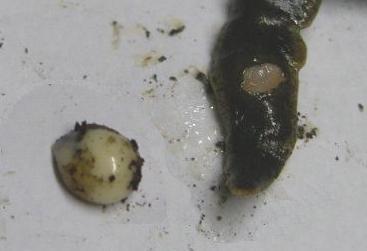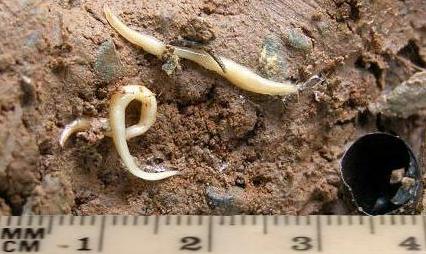The New Zealand Flatworm, Arthurdendyus triangulatus, was first sighted in Northern Ireland in 1963 and probably arrived in the root-ball of a plant. At the time a local nurseryman had links to the antipodes exploiting the different seasional cycles to source his stock - he eventually sold up and emigrated to New Zealand. It has since spread all over the British Isles, but sightings are still more concentrated in Northern Ireland and Scotland. It lives on earthworms and will greatly reduce their population, sometimes to below detectable levels - research by the Agri-Food & Biosciences Institute of N. Ireland in 2013, found it reduces earthworm numbers by 20 per cent.
Observations in parts of Scotland have shown that in some areas the earthworms are not wiped out and a sort of equilibrium is reached. In some places the flatworms appeared to die out. This is thought to occur in drier regions as the flatworm prefers damp conditions as it originates from woodland areas. I have found that they like the damp air pockets in stone-filled land drains and hardcore infill. Egg capsules are usually quite numerous in these spots if an area is infested. Unfortunately this could be a way for them to spread in pasture. Most are just empty cases and may have been carried there by a predator.
At rest. The front is the more pointed end when it is moving
They have flat, purple-brown bodies with buff-coloured undersides and edges, pointed at both ends and covered with a sticky slime. At rest they are about 1cm wide by 6cm long, extending to about 12cm when they move, but narrower. They are usually found coiled up with a 'halo' of slime under pots, stones, wood or pieces of polythene, where the surface is damp - not crawling about unless distrubed and heading for cover. I have observed them among clusters if slug eggs so hopefully they consume them as well.
The under side is paler
When feeding they seem to lie on top of the earthworm, perhaps using their sticky mucus to hold on, excrete digestive enzymes which liquidise the worm, and absorb the soup that results. They either wait for the worms to surface or follow their borrows and other channels in the soil and can detect the scent left behind in the mucous trail of the worm. Although species of earthworm which stay near to the surface would appear to be more at risk, studies have shown that the flatworms prefer the larger species which live deeper down. When the food supply decreases they shrink in size and can survive in this state for one or two years until the worms return.
Reproduction is asexual by parthoengenesis, ie. no mate required. A soft white sack swells from a temporary opening in the back of the worm near to the rear end. The white liquid content does not have any wormlike structues at first. The opening in the worm heals leaving a whitish scar for a short time.

This shows a fresh egg and the scar where it emerged
from the worm - the dark bits are soil.
The hard, shiny black outer coating forms over the surface to give it physical protection and to prevent it from drying out. Two to eleven small flatworms develop inside the oval shell which is about 7-8 mm by 5mm accross.
This clutch of eggs was found under a stone, the inset shows the immature content. |  Juvenile flatworms from a broken egg. |
New Zealand Flatworms are a great threat to soil condition and the wildlife which feed on earthworms, and every means should be employed to prevent their spread and eradicate them if possible. Some pastures in Northern Ireland have become waterlogged due to the loss of the earthworm population. Unfortunately many have been shared between friends as they swap plants.
There are no approved chemical controls, but Ground and Rove beetle adults and larve are known to prey on the adults. Birds have taken them as well, but because of their habitat they are rarely exposed to them. By adding lots of organic matter the population of earthworms can be improved. It is possible to trap the flatworms by laying sheets of black polythene, or placing bin-bags of compost around and collecting any which congregate underneath. They can be moved to another site accidently if they cling to a bag or plant pot - farmers have been moving them around on the large polythene-wrapped silage bales. Chopping them up may not be enough to kill them as I have seen small pieces crawling away, although I don't know how long they would have survived as I didn't give them the chance! So grind them up between two stones, add to very salty or boiling water, or burn them - better still, do all four. Charles Darwin made an observation in his notebook about the regeneration of flatworms that had been cut in half - the only terrestrial animal he named when he visited Tasmania was the flatworm Tasmanoplana tasmaniana (Darwin). It has been reported that the maggot of a Tasmanian gnat parasitises the flatworm. They could be a solution to the problem if they can be used as a biological control, but further research is needed to show that we won't be overrun by gnats instead, or they could attack another native species. Another possible solution could be climate change as the lethal temperature for these flatworms is 23°C, so as they are creatures of forests in their native habitat with damp moist conditions, an increase drier, warmer conditions in summer could greatly reduce their numbers. If you find one of these creatures, scientists studying their distrubution may be interested in it. You can find information of where to send the flatworm at the Central Science Laboratory information page A relative, the Australian Flatworm - Australoplana sanguinea alba, has also moved to the British Isles, but is spreading northwards having been first sighted in the Scilly Isles in 1980. It does not seem to pose as big of a threat as its New Zealand cousin - so far!. |
Back to GARDEN CREATURES